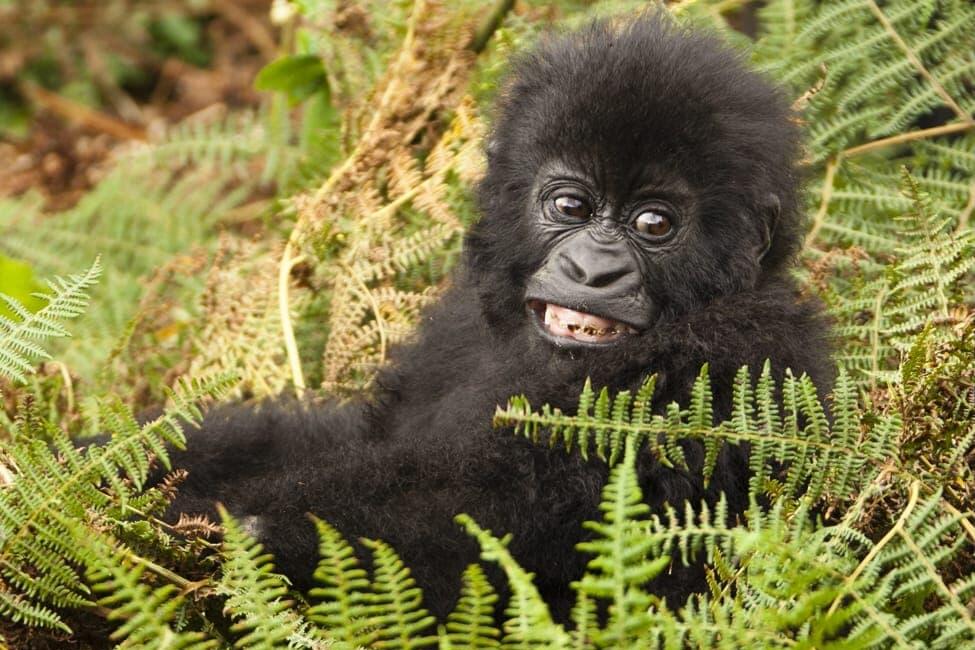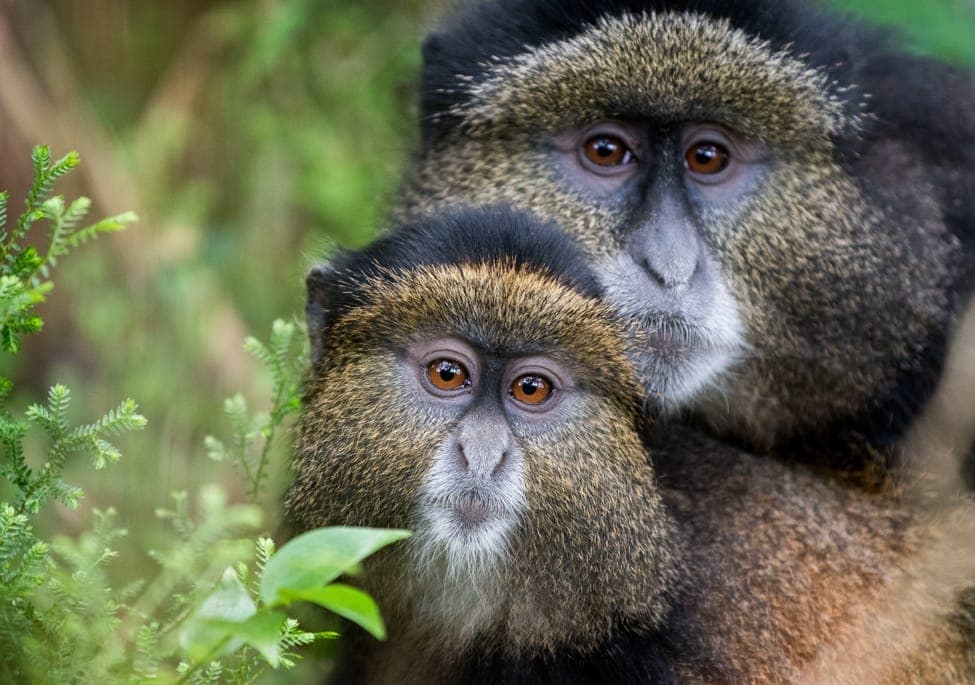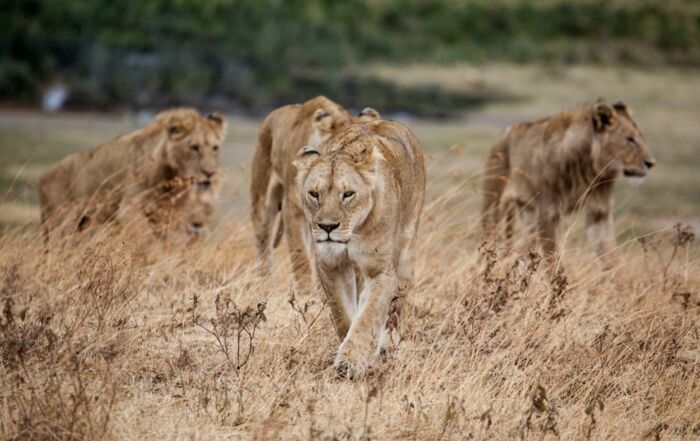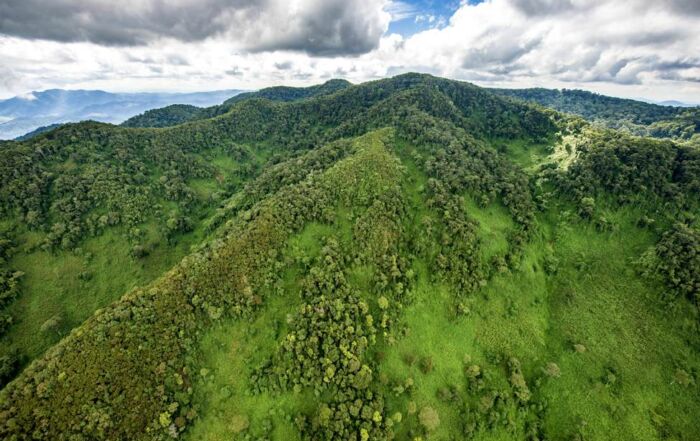Where to See Chimpanzees on Safari
The best places for a chimp trek in East Africa
As you embark on your chimp trek, your guide looks for last night’s nests—clumps of leaves high in the dense canopy that you wouldn’t have noticed on your own. You follow a trail marked by bent twigs and discarded pieces of fruit, full of bite marks. The songs of unfamiliar birds echo through the forest.
Suddenly, a tree limb sways. You hear the loud rustling of leaves accompanied by a hoot. You look up and find yourself face to face with our species’ closest living relative: the chimpanzee.
“It was like being in a documentary, but it was real and live. It wasn’t the Nature Channel. It was us, experiencing it,” Ujuzi traveler Aleta Chossek said of her encounter with chimpanzees while on safari in Uganda.
Want to see chimpanzees in the wild? This article tells you what it’s like to go on a chimp trek and the best places to see chimpanzees in East Africa.
Most chimps in East Africa are in western Uganda and Tanzania, the country where primatologist Jane Goodall made her ground-breaking observations of chimp behavior.
But you also have a chance of seeing chimps in Rwanda—a country also famous for another great ape, the mountain gorilla. You can even see them in Kenya. They aren’t native there, but two groups of chimpanzees live in Ol Pejeta Conservancy near Mount Kenya. (How did they get there? Read on to find out!)
About our ratings
We’ve rated each destination according to the difficulty of the terrain and the likelihood of seeing chimps if you visit the park for only one day. However, don’t let a “low” or “medium” likelihood rating turn you away from a specific park. For any of these locations, the odds of seeing chimpanzees are high if you go out on multiple days.
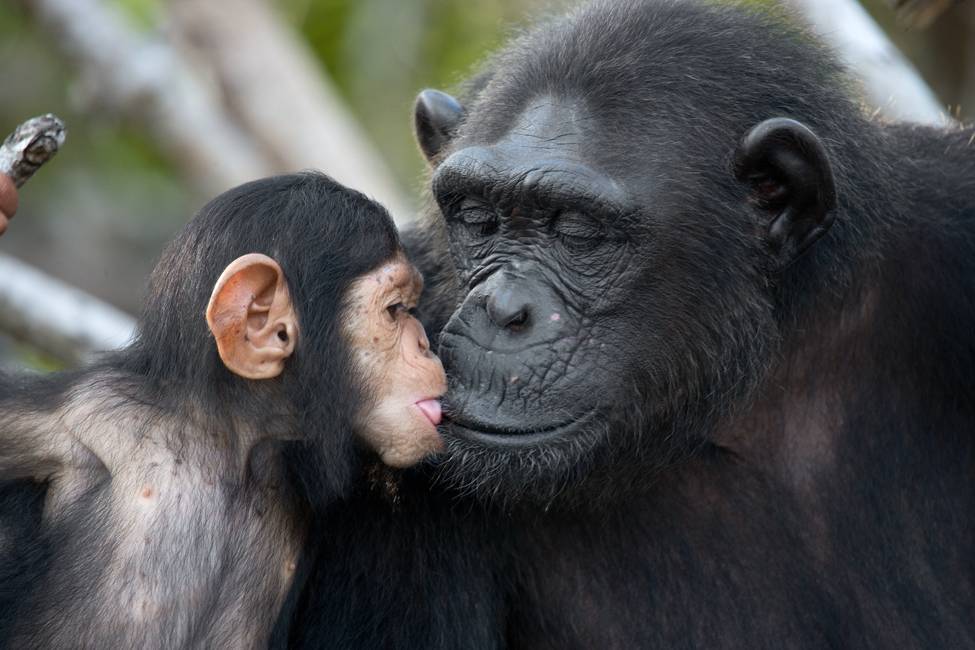
What’s so cool about chimps?
Chimps share 98% of our DNA, and they have a lot of other things in common with us, too. They are sociable, living in small communities of up to 120 chimpanzees — the size of a small human village. They babysit each other’s children. They have sibling rivalries. Young ones love to play and come up with new games (sometimes to the irritation of adults). They use tools and even have cultural differences between groups!
What to expect on a chimp trek
How long does a chimp trek take?
Chimp treks are a unique type of walking safari and vary widely depending on where you are. In several parks, chimpanzees live close to main roads and trails, so you are likely to see several on a guided hike of two to three hours.
At other parks, the chimpanzees live in remote areas. Your chimp trek may last all day. You get up early in the morning, when it’s still dark, so you can start tracking chimps at daybreak. You then follow them with the help of experienced guides. You may need to go through thick underbrush and over rough terrain. But these hikes are part of the fun—you are likely to see gorgeous birds, playful monkeys, and other fascinating creatures on your way.
At a few sanctuaries, you may only wait minutes to see chimps. These sanctuaries are home to chimpanzees (and often other endangered species) rescued from captivity. The chimps live freely in nature, but many remain interested in humans and tend to hang around near visitors centers and other places frequented by “hairless apes.” They’re just as curious as we are to see what their evolutionary cousins are up to!
Do I need a guide for my chimp trek?
To protect the chimps and ensure the best possible sightings, you are required to hire a guide for most chimp treks. (Ujuzi can take care of this before you leave for your trip.) Guides play an invaluable role in helping you find chimps and explaining their fascinating behavior to you. If you wish to tip your guide for their knowledge and effort but aren’t sure how much, consult our article about tippping on safari.
What precautions should I take on a chimp trek?
These days, we’re all familiar with how quickly infections can spread among humans.
But did you know many infections can also spread between humans and chimpanzees? Because of this, you shouldn’t go on a chimp trek if you have a fever or are not feeling well.
Even if you feel great, keep your distance when you see chimps on a trek. A distance of about 25 feet is a good rule of thumb—but follow your guide’s directions. This not only protects the chimpanzees from germs. It also lets the chimps know that you’re not a threat.
Other things to keep in mind:
- Don’t eat in front of the chimps. Like your elementary teachers told you: It’s rude to eat in front of others if you’re not going to share. And you really don’t want to share with a wild chimpanzee. (Okay, maybe they didn’t say that last part.)
- No flash photography. The flashes can scare or disorient the chimps.
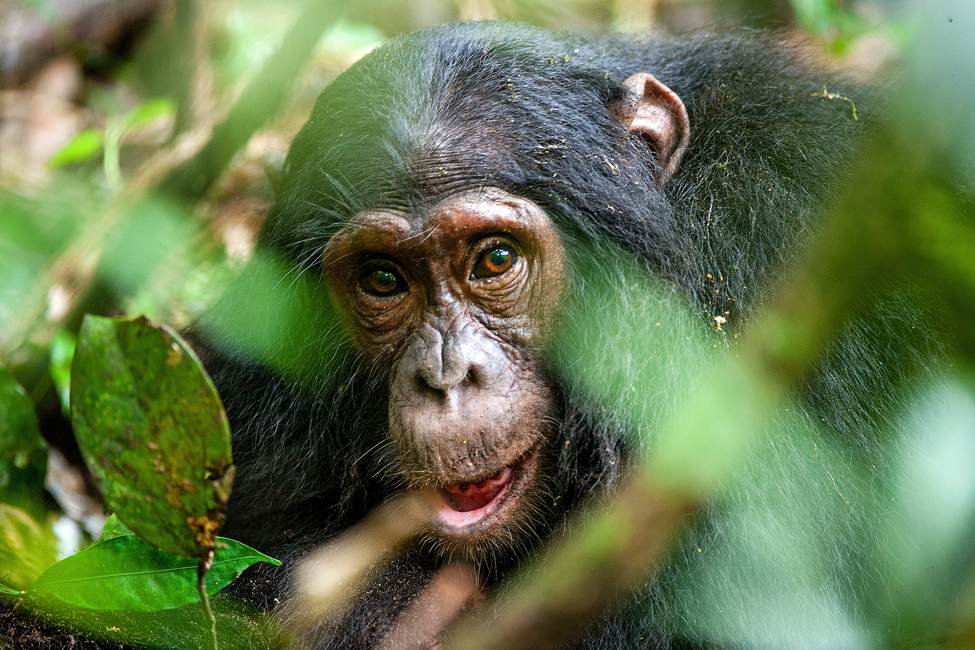
Best Places to See Chimps in Uganda
Budongo Forest, Murchison Falls Conservation Area
Lying on the southern end of the Murchison Falls Conservation Area, Budongo Forest is home to 600 to 700 chimpanzees. They live in several communities scattered throughout the 500 square mile forest. Each community has 50 to 120 chimpanzees—the size of a small human village.
Your best chance of seeing one of these chimps is in Kaniyo Pabidi, an area on the northeast edge of Budongo Forest. Unlike mountain gorilla treks, which always start first thing in the morning, chimp treks at Kaniyo Pabidi take place in both the morning and afternoon. Here, you can take a guided walk in the morning or afternoon.
The walk includes some steep inclines, but is mostly along well-maintained paths.
You have a very good change of seeing chimps on your walk. This is especially true in May through August, when the forest provides the chimps with plenty of fruit. With so much food around, the chimps can stay in one area instead of wandering to satisfy their hunger. This makes the chimps easier to find.
Difficulty: Moderate
Chance of sightings: High
Kibale Forest National Park
Have you ever wondered what it would be like to be Jane Goodall for a day? You can find out at Kibale Forest National Park.
Located in Western Uganda, Kibale Forest is an hour drive from the town of Fort Portal. The forest has a rich habitat for primates, with chimpanzees being the most famous inhabitants. You have two options for getting up close and personal with this fascinating creature in Kibale:
- take a morning or afternoon chimp trek
- spend the day observing chimpanzees with field scientists
The field option is truly one of a kind. You’ll stay with one group of chimps all day, taking notes about their behavior and interactions. This is a dream come true for primate lovers and aspiring researchers.
Enjoy a chimp trek in Kibale with our Pearl of Africa itinerary.
Difficulty: Moderate
Chance of Sightings: High
Kyambura Gorge, Queen Elizabeth National Park
The lush rainforest of Kyambura Gorge in Queen Elizabeth National Park is home to habituated chimpanzees and many other primates. The best time for a chimpanzee trek is in the morning when temperatures are cooler. However, treks can also be made in the afternoon.
The trails are maintained and once you are inside the gorge, you won’t encounter many significant inclines. However, the climb back out of the gorge is steep and can be difficult.
Reenergize after your trek by sampling java at a local women’s coffee cooperative that helps protect the chimps.
Difficulty: Challenging
Chance of Sightings: Medium-High
Ngamba Island Chimpanzee Sanctuary
Ngamba Island Chimpanzee Sanctuary lies off the northern shore of Lake Victoria, a short boat ride from Entebbe, and offers a safe haven for chimps rescued from the pet or bushmeat trade or released from laboratories. With no predators around, they can safely learn to be wild again at their own pace.
The chimps are free to roam, explore their environment, and forage for food. Twice a day, caretakers offer supplementary feedings of fruits and other treats to ensure that chimps who are less skilled at foraging still get a healthy diet. Visitors can view the feedings from a raised walkway, getting a unique opportunity for close viewing of chimpanzees.
Visitors can also walk through the island to see chimps in their natural forested environment.
Difficulty: Easy
Chance of Sightings: Guaranteed
Semliki Wildlife Reserve
The Semliki Valley, deep in the heart of Uganda’s western rift valley, is a prime conservation area. The chimps here are famous for walking and standing on two legs more often than other chimpanzees. They are also quite the engineers—they dig small wells to get drinking water in the dry season.
And they’re more peaceful than most other chimps. According to biologists at the Simliki Chimpanzee Project, they get into fewer fights that lead to injuries. They even hunt less than other chimps.
However, they are also harder to see than in other parks. Your chimp trek will take you over varied terrain, and the chimps may be a little more reclusive than at other parks.
But many visitors see the longer hike as a benefit. Because Semliki lies on the boundary between Central African rainforest and East African savannah, the scenery here is breathtaking.
Difficulty: Moderate
Chance of Sightings: Medium
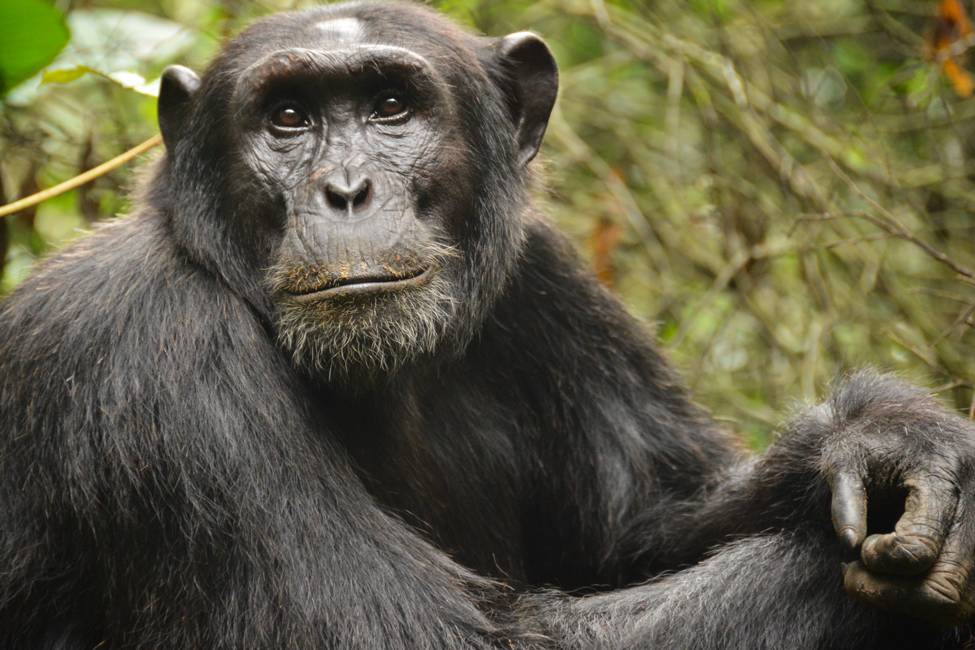
Best Places to See Chimps in Tanzania
Gombe Stream National Park
Gombe is where Jane Goodall started out her ground-breaking research on chimp behavior starting in 1960. Since then, an international team of primatologists and ecologists have joined the work she started and continue it today!
Gombe is the smallest of Tanzania’s national parks. This fragile strip of chimpanzee habitat straddles the steep slopes and river valleys north of Lake Tanganyika.
The most visible of Gombe’s other mammals are also primates. Beachcomber olive baboons can often be seen on the forest floor, while red-tailed monkeys and red colobus monkeys stick to the forest canopy.
Difficulty: Moderate to Challenging
Chance of Sightings: High
Rubondo Island National Park
Protected by the waters of Lake Victoria, Rubondo Island is a sanctuary for endangered animals. Chimpanzees first came to the island in the 1960s after being raised in European zoos and circuses. They have thrived here, giving rise to new generations that are truly wild.
Walking and hiking are the only ways to explore this island. While chimps may be your main draw, you’ll also enjoy watching the island’s African gray parrots—among the world’s smartest birds. These parrots aren’t native to Tanzania (they come from further west), but were brought here after being rescued from the illegal pet trade. You can sometimes find them close to chimps because they both like many of the same foods—especially figs!
You’re likely to see many native animals as well, from the elusive sitaunga antelope to the majestic hippo.
Difficulty: Easy to Moderate
Chance of Sightings: Medium
Mahale Mountains National Park
Mahale Mountains National Park is one of Africa’s best-kept secrets when it comes to wildlife viewing. Its lush green hills are home to roughly 800 chimpanzees.
While chimpanzees are the star attraction, birds turn the slopes into a kaleidoscope of color each morning. The monkeys are almost as showy—red colobus, red-tailed monkeys and blue monkeys are among those you may see.
Chimp treks take place year round. But the best months to visit are between July and November, when the park’s resident animals gather around shrinking water holes.
Difficulty: Moderate
Chance of Sightings: Medium
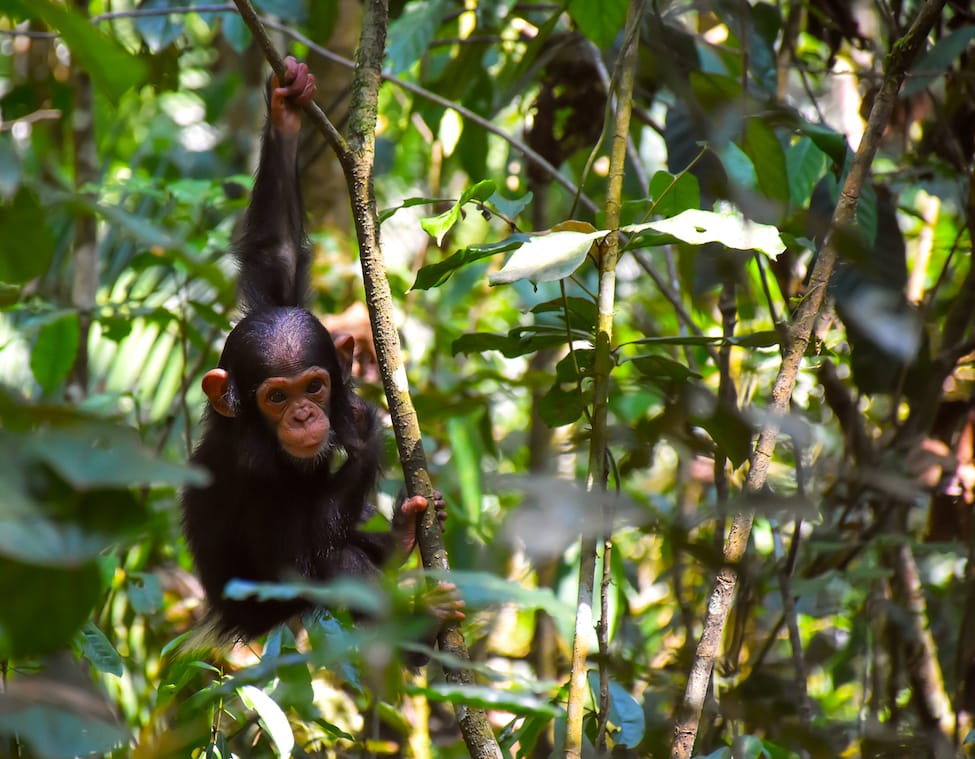
Best Places to See Chimps in Rwanda
Nyungwe Forest National Park
Home to chimps and a dozen monkey species, Nyungwe Forest is a dream come true for primate lovers. Besides chimpanzees, you might see black-and-white colobus monkeys, blue monkeys, L’Hoest monkeys, and the endangered golden monkey.
In fact, the majority of the chimp population in Rwanda lives in Nyungwe Forest National Park. These groups of chimps range far and wide, so finding them can be difficult—most of the year, you have about a one in three chance of spotting them if you go chimp trekking on only one day. Visiting the park on multiple days increases your chances.
Opportunities to see chimps are more abundant from June to August, when fig trees burst with fruit. For chimps, a fig tree in fruit is like an all-you-can-eat buffet that’s free and lasts for days. And like humans, chimps don’t move quite as fast when they’re stuffed with food.
Nyungwe features extensive networks of well-maintained walking trails, including a suspended walkway high in the canopy that lets you glimpse creatures you wouldn’t otherwise see. But when looking for chimps, you may need to go off trail.
Difficulty: Moderate to High
Chance of Sightings: Medium-low
Gishwati-Mukura National Park
Rwanda’s newest national park, Gishwati-Mukura opened to visitors in 2020. It preserves the remaining remnants of the formerly expansive Gishwati and Mukura forests. Gishwati Forest once stretched almost all the way to Volcanoes National Park to the north, but shrunk over the years due to farming, mining, and movement of the human population after the 1994 Rwandan genocide.
In 2004, the chimp population in Gishwati-Mukura was nearing zero. Several conservation groups began working together to reforest the area and protect chimp habitat. Their efforts have been fruitful. Today, about 35 chimps live in Gishwati Forest, along with several monkey species and 125 bird species.
Being new, the park is somewhat of a secret and has relatively few visitors—a plus for any traveler who enjoys solitude and quiet. Accommodations are within the park near the Gishwati Research Station, giving quick access to trails. The Forest of Hope Guest House is an intimate lodging with two guest rooms and chef-prepared meals. Staying at the neighboring camp site is also an option.
To look for chimps or other primates, you can hit the trails in the morning after breakfast. Then, with the help of experienced trackers, you’ll head for the last spot they were seen. The hike can last a few hours. Even though there are only two troops of chimps in Gishwati-Mukura, chances of a sighting are good due to the park’s small size.
Difficulty: Moderate (dry season) to High (wet season)
Chance of Sightings: Medium-High
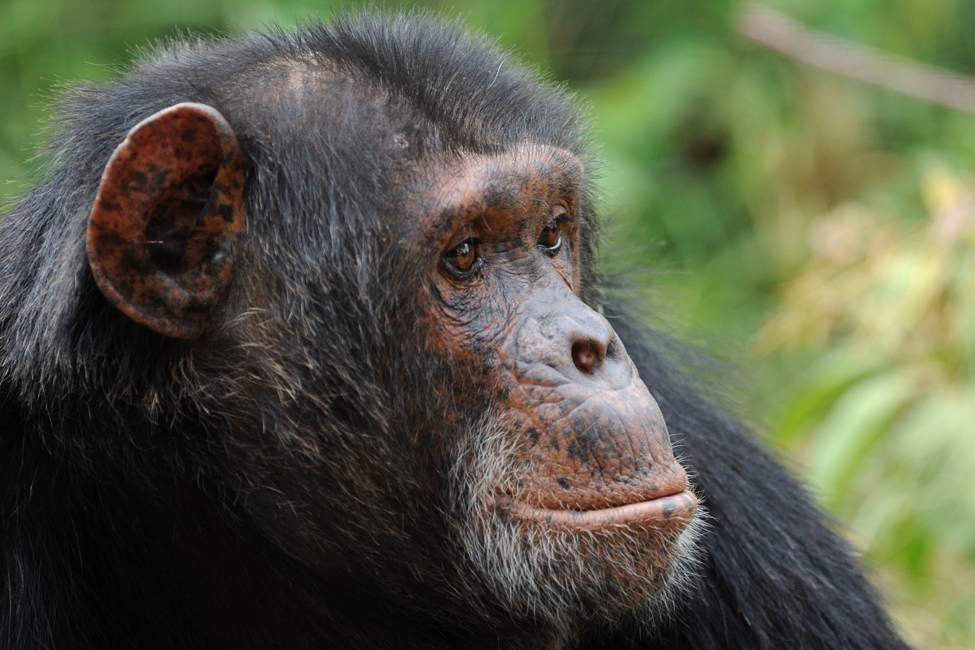
Best Place to See Chimps in Kenya
Chimpanzees are not native to Kenya, but a group of rescued chimps lives in the wild at The Sweetwaters Chimpanzee Sanctuary in Ol Pejeta Conservancy. These chimps were orphaned or rescued from abuse by humans, so they lack the skills to survive completely on their own. After being nursed back to health, the chimpanzees spend their days exploring, climbing, socializing, and learning to be chimpanzees all over again. This is an amazing project supported by the Jane Goodall Institute.
How did a sanctuary for chimps end up in Kenya? In the early 1990s, a civil war in Burundi threatened a rescue center there. Ol Pejeta agreed to provide a safe home to these chimpanzees.
On your visit, you may see some of those original chimps as they enjoy their golden years in this peaceful setting!
Visit Ol Pejeta on our Legendary Kenya + Zanzibar Safari.
Difficulty: Easy
Chance of Sightings: High
Enjoy a Chimp Trek on These Safaris
Plan your African safari!
It’s worth going to East Africa just for the chimpanzees.
But why stop there when you can have the safari of your dreams?
Take a mountain gorilla trek, see the Big 5, watch the great wildebeest migration, explore local cultures, and get a bird’s eye view of Africa in a hot air balloon!
Ujuzi African Travel will customize your trip to your wish list. Contact us today!
Sign up for the Ujuzi Newsletter!
From top travel tips to innovative safaris and conservation movement, get inspired to plan your next African safari!


